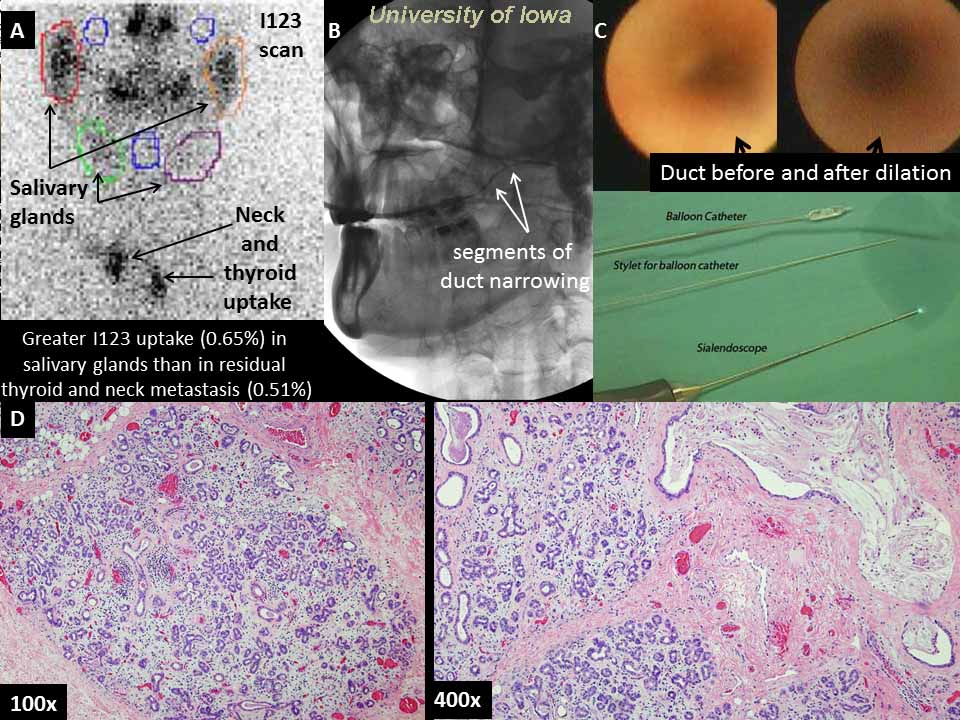see on-line book chapter addressing Radioiodine Sialadenitis (Hoffman et al 2014): https://link.springer.com/article/10.1007/s40136-014-0041-1
Background
- Salivary gland swelling, pain and dry mouth reported in 2% to 67% of I131 exposed population in a dose dependent fashion (Van Nostrand 2011)
- Factors associated with I131 sialadenitis include dose and timing of administration, previous history of salivary gland disorders, other causes of I131 retention (Canzi 2017)
Prevention and Management of Dry Mouth associated with I131 Treatment
Role for Sialography (see Thorpe et al 2020)
- Ductal stenosis is a prominent finding identifying value in doing diagnostic sialography (see: Sialograms and Sialography) which may have therapeutic value as well
Role for Sialendoscopy
Systematic literature review for use of sialendoscopy in treatment of I131 sialadenitis (Canzi 2017) with last search 9-30-2016
- 8 studies; level of evidence 4 in all but one that was level 3 (mean I131 dose of 163.7 mCi ranging between 107 to 250 mCi)
- 7 studies: subjects submitted to interventional sialendoscopy only after conservative measures failed
- conservative measures: not well defined
- interventional sialendoscopy:
- duct stenosis and mucous plugs were observed in 85.7% of endoscopic findings
- reported improvemnet in painful swellings in 89.3% of cases with no major events
- irrigation with saline coupled with steroid insufflation (7 of the 8 studies; single study without steroids used saline/gentamycin mixture)
- additional techniques balloon dilation, salivary stent positioning not well documented/studied
- conflicting data about impact of sialendoscopy on xerostomia:
- Bhayani et al: Symptomatic and sialometric benefits in treating xerostomia with sialendoscopy (Bhayani 2015)
- Kim et al: No significant differences in xerostomia symptoms pre- vs post- sialendoscopy (Kim 2016)
- 7 studies: subjects submitted to interventional sialendoscopy only after conservative measures failed
More detail regarding Case Example I131 Sialadenitis
Case Example Sialadenitis Treated with Sialendoscopy (useful for 3 of four glands) and sialadenectomy (one submandibular gland)

A. I123 scan done one month after total thyroidectomy with salivary uptake (0.65%) greater than thyroid remnant and neck metastasis uptake (0.51%). Note the greater uptake in the parotid glands than the submandibular glands.
B. Left parotid sialogram done 8 months after administration of 187.7 mCi of I131 identifies multiple areas of short segment narrowing and dilation of the main parotid duct.
C. Bilateral parotid sialendoscopy was done with duct narrowing and debris identified. Successful balloon dilation is identified by pre- and post-dilation imaging with sialendoscopy
D. Histopathology of the resected submandibular gland identified mild lobular inflammation with depletion of acini and acinar atrophy. (Left image 100x). Ductal dilatation with accompanying attenuation of ductal mucosa along with early squamous metaplasia of the ducts is present. Ductal concretions are demonstrated as is early periductal fibrosis. (Right image 400x)
References
Thorpe RK, Foggia MJ, Marcus KS, Policeni B, Maley JE, Hoffman HT. Sialographic Analysis of Radioiodine-Associated Chronic Sialadenitis. Laryngoscope. 2020 Nov 17. doi: 10.1002/lary.29279. Epub ahead of print. PMID: 33200832.
Canzi P, Cacciola S, Capaccio P, Pagella F, Occhini A, Pignataro L, Benazzo M. Interventional sialendoscopy for radioiodine-induced sialadenitis: quo vadis? Acta Otorhinolaryngol Ital. 2017 Apr;37(2):155-159. doi: 10.14639/0392-100X-1606. PMID: 28516979; PMCID: PMC5463524.
Van Nostrand D. Sialoadenitis secondary to ¹³¹I therapy for well-differentiated thyroid cancer. Oral Dis 2011;17:154-61
Bhayani MK, Acharya V, Kongkiatkamon S, et al. Sialendoscopy for patients with radioiodine-induced sialadenitis and xerostomia. Thyroid 2015;25:834-8
Kim YM, Choi JS, Hong SB, et al. Salivary gland function after sialendoscopy for treatment of chronic radioiodine-induced sialadenitis. Head Neck 2016;38:51-8.
Wu CB, Xi H, Zhou Q, et al. Sialendoscopy-assisted treatment for radioiodine-induced sialadenitis. J Oral Maxillofac Surg 2015;73:475-81.